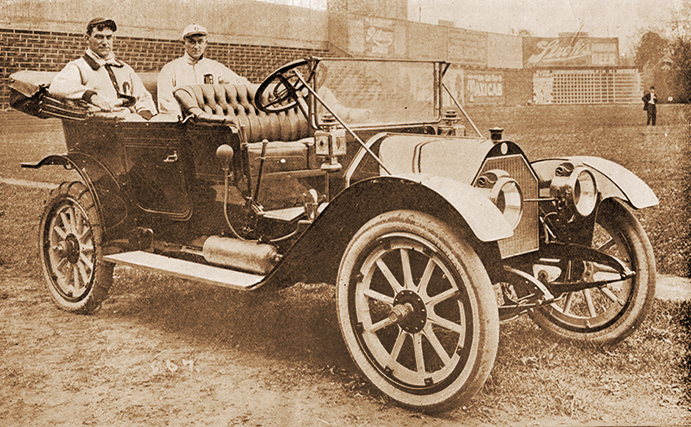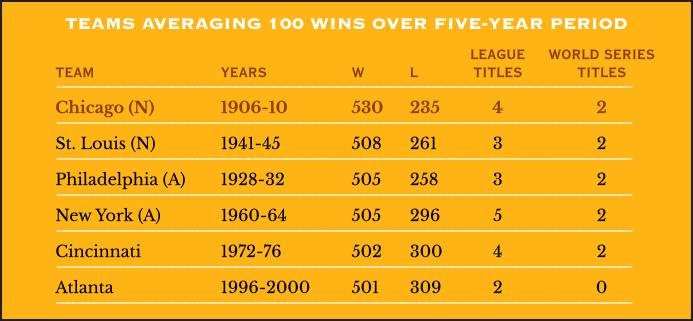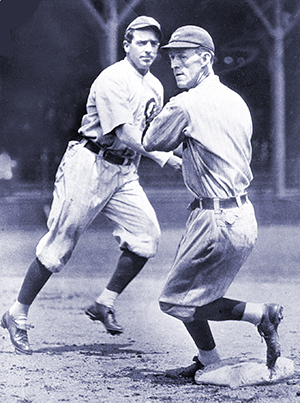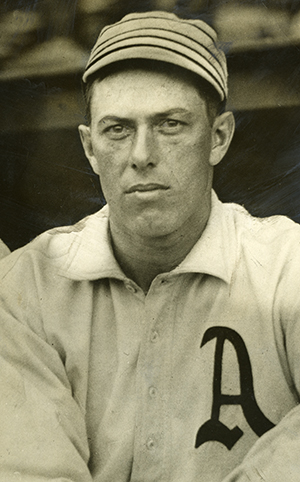THE YEARLY READER
1910: A Carload of Trouble
The World Series becomes anticlimactic following a strange and controversial ending to the individual batting race between two of baseball’s premier hitters: Ty Cobb and Nap Lajoie.

Cleveland’s Nap Lajoie (left) and Detroit’s Ty Cobb take a backseat in the luxurious Chalmers 30 as their highly publicized batting race went into high gear and resulted in one of baseball’s most controversial endings. (The Rucker Archive)
A four-cylinder engine. Thirty horsepower. An exquisite exterior with plush vinyl upholstery on the inside, protected by a retractable top. Excellent for touring.
It was the Chalmers 30, and starting in 1910, it was yours if you had the best batting average in major league baseball.
Throughout the season, many of the game’s finest hitters played musical chairs with the top spot of the batting charts in a bid to secure one of the sweetest automobiles Detroit had to offer. But toward season’s end, only two of the game’s very best remained the last men running in the race for the Chalmers: Nap Lajoie and Ty Cobb.
Between them, Lajoie and Cobb had won six batting titles over the American League’s first nine years. Lajoie was so well liked and highly regarded, they renamed the team after him when he came to Cleveland. Cobb, on the other hand, remained the consensus choice for the most hated man in baseball, thanks to his vicious attitude toward almost everything in life.
Both pennant races long decided, the baseball public became transfixed on the Lajoie-Cobb race. The two players were into the drama as well; in an era where a gift such as a sparkling new car could greatly augment a player’s yearly worth, extra income was nothing to yawn at.
At midseason, Lajoie appeared all but a lock for the Chalmers’ keys, leading Cobb by 30 points. Cobb, bothered by eye problems for much of the year, was all 20/20 over the season’s final two weeks—batting .550—to suddenly jump ahead of Lajoie, .382 to .376, going into a doubleheader to end the year.
Rather than risk the batting crown and the Chalmers with two bad games, Cobb opted to sit—officially complaining that his eyes were acting up again. Others rolled their own eyes back, suspicious that Cobb was simply practicing protectionism from the dugout.
Meanwhile, Lajoie and his Naps readied for a season-ending doubleheader of their own in St. Louis—where Browns manager Jack O’Connor was going to make sure that Lajoie, not Cobb, would get that car. After all, Lajoie was far more popular within and outside the lines, and the Browns weren’t going anywhere except a miserable last-place finish of 47 wins and 107 losses.
In his first at-bat of the doubleheader, Lajoie smashed a triple against the Browns. When he came up for his second at-bat, Lajoie noticed St. Louis third baseman Red Corriden positioned well behind the bag, almost out into left field. Capitalizing on this defensive alignment, Lajoie bunted cleanly down the third base line; by the time Corriden had rushed in to field the ball, Lajoie was crossing the bag at first, his second hit in two at-bats.
Thinking the Browns’ defense would react by moving their infield in his next time up, Lajoie was stunned to again see Corriden remaining stationed well behind third base. Lajoie offered the bunt once more toward Corriden, who again failed to throw him out.
This pattern continued all through the day—Lajoie bunting, Corriden sprinting in too late—and before the twinbill was over, Lajoie had laid down six bunt hits. It was more than obvious: The Browns were literately handing the batting title—and the car—to Lajoie.
E.V. Parish, scoring the game for the Browns, quickly caught onto what was up, but there was little he could do; a hit was a hit. Even after Parish scored one of Lajoie’s bunt attempts an error (when Corriden threw wildly past first base), he was approached by St. Louis team assistant Harry Howell, who on orders from O’Connor promised Parish a new suit if he’d changed the scoring of the error to a hit.
Deciding he’d rather be three pieces of wardrobe poorer than be part of an outrageous, thinly-veiled conspiracy, Parish refused the bribe. It didn’t matter; the seven hits in eight at-bats gave Lajoie his fourth AL batting title, barely edging out Cobb. Or did it?
BTW: Underscoring the hatred for Cobb even from his own teammates, numerous Detroit players telegraphed congrats to Lajoie following his tarnished doubleheader performance.
In a time when it was hard to find the official gospel on statistics, the final word on who won the AL batting title depended on what newspaper you read. Some had Lajoie winning by a whisker, others had Cobb out in front.
To a man, the press didn’t like Ty Cobb, but they hated scandal even more. And they all felt Cobb had been scandalized by the Browns. Even the papers in St. Louis sided against the doings of their home team, calling the suspicious defensive tactics against Lajoie a “deplorable spectacle”—adding that the city “should subscribe to a fund to buy Ty Cobb a Chalmers.”
AL President Ban Johnson, who above all others detested the notion of game-fixing, got to the bottom of it. When he was done, everyone involved got his fair share of just desserts. O’Connor and Howell, already fired from the Browns for the incident, were banished from the game for life. Corriden, who was only following orders, was allowed to play on. And Ty Cobb was officially awarded the batting title when Hugh Fullerton, a New York sportswriter who scored games for the Highlanders, realized he should have restored a hit to Cobb that was originally ruled an error during an earlier game between Detroit and New York.
Harry Chalmers, realizing that his desire to spread promotional goodwill had become an unwanted exercise in favoritism fueled by greed, played the good sport. He awarded both Lajoie and Cobb with Chalmers 30s. In following years, however, Chalmers’ cars would be given not to the batting champ but, instead, to the player voted by sportswriters as the best in the game; it would become baseball’s first iteration of the Most Valuable Player award.
Statistical revisionists have continued to make the Cobb-Lajoie controversy a lively issue. In 1981, The Sporting News discovered that a 1910 game in which Ty Cobb played and collected two hits had accidentally been counted twice in the final records. Deleting the copied game, Cobb had suddenly—and posthumously—fallen a batting point behind Lajoie, who was re-crowned with the title. Most other statistical bureaus of the day agreed, but the commissioner’s office stated that the matter was closed, and that Cobb officially remained the 1910 American League batting champion: Cobb .3849, Lajoie .3841.
BTW: This Great Game uses the final numbers provided by retrosheet.org, which shows Lajoie at .3834, Cobb .3818.
So much attention had been paid to the controversy surrounding the two superstars, many had forgotten that there was a World Series still to be played.
The Chicago Cubs, overpowered by Pittsburgh a year earlier despite playing so well, regained the top spot in the National League. A newfound offense was led by sluggers Wildfire Schulte, who led all National Leaguers with 10 home runs, and Solly Hofman, whose .325 average was second only to Sherry Magee for the NL batting crown (but no Chalmers 30). On the mound, the Cubs continued to field the NL’s best; Three Finger Brown remained the staff’s most reliable, winning 25 for his fifth straight year above 20, while rookie King Cole emerged with a 20-4 record, highlighted with a NL-best 1.80 earned run average.
The Ultimate Five-Year Plan
With 104 wins in 1910, the Cubs finished a five-year period in which they totaled 530 victories—an all-time high average of 106 per season. Below is the list of all major league teams who have annually averaged at least 100 wins over a five-year period.

The Cubs’ 104 wins gave them a five-year total of 529—an astonishing average of 106 a year, all under the tutelage of player-manager Frank Chance. The Giants finished a distant second, and the Cubs’ easy return to prominence led New York poet Franklin P. Adams to write a somber piece entitled Baseball’s Sad Lexicon. Told from the perspective of a Giants fan, the poem spoke, “These are the saddest of possible words…Tinker to Evers to Chance,” in reference to the unfailing Cub double play combination. It has gone on to become one of baseball’s most legendary pieces of literature.

Johnny Evers throws on to Frank Chance after completing the first half of a double play from Joe Tinker (left). Franklin Adams’ poem Baseball’s Sad Lexicon added more to the immortality of the Tinkers-to-Evers-to-Chance connection than their performance, which was barely a bit above par; yet it didn’t keep the three from being inducted into the Hall of Fame together in 1946. (The Rucker Archive)
The American League race was also sapped of suspense thanks to a runaway powerhouse of its own: The Philadelphia Athletics. Knocking Detroit off an AL throne it had sat on for three straight years, the A’s became the first team in the junior circuit’s 10-year history to produce 100 victories. Though their youthful and quickly maturing infield continued to solidify the offense, the real strength of the A’s lay in their pitching—whose 1.78 ERA set an all-time AL low. Four starters carried the A’s throughout the year, accounting for all but 14 of their wins. Each of their ERAs—1.30, 1.55, 1.58, 2.01, produced respectively by Jack Coombs, Cy Morgan, Chief Bender and Eddie Plank—told the combined story of the A’s unparalleled success.
While the latter three were well-known veteran hurlers, Coombs’ place within the rotation produced numerous double-takes. A player who had split his career with the A’s as an ordinary pitcher and part-time outfielder, Coombs went full-time as hurler in 1910 and, having developed a terrific drop curve, commanded the pitching stage unlike few before him or since. His 31 wins led all major leaguers, and he only got better as the season elapsed, winning 18 of 19 from July through September—during which he had a string of 53 consecutive scoreless innings thrown. In 25 of his 31 wins, he allowed a run or less, with 13 of those shutouts—an AL record.
BTW: Coombs’ scoreless streak set a record that would be topped by Walter Johnson in 1913.
Both the Cubs and A’s entered the World Series handicapped. Chicago had lost shortstop Johnny Evers just days before season’s end with a broken leg, sustained while attempting a slide at home plate. Meanwhile, veteran Eddie Plank’s arm had become so sore, manager Connie Mack scratched him from the A’s starting rotation.

If coming out of relative obscurity to win 31 games during the 1910 regular season wasn’t amazing enough, Philadelphia pitcher Jack Coombs won three more games during the World Series—over a space of just six days. (The Rucker Archive)
The A’s won all three.
Chicago averted a sweep by getting past Bender in Game Four, but had to tie it in the ninth and win it in the 10th to do so. For Game Five, the Cubs couldn’t believe their eyes to see Coombs on the mound for the third time in six days. And yet again, Coombs emerged victorious, giving Connie Mack and the Athletics total triumph.
The A’s battered Chicago pitching with a .316 team average—highest yet in a World Series—aided by a lively cork-centered ball used partially during the regular season (but only in the NL) and entirely during the Series. Helping to lead the way at the plate were—surprise, surprise—Bender and Coombs. The pitching duo was just as sharp with the bat, combining to hit .368 while knocking in four runs.
Despite their status as the AL’s most consistently successful team to date—they had finished below the .500 mark only once over their first 10 years—the A’s finally won their first-ever World Series. It would hardly be their last over the near future.
Connie Mack’s first dynasty was off and running.
 Forward to 1911: The Legend of Home Run Baker Frank Baker famously powers the Philadelphia Athletics past an aggressive New York Giants squad in the World Series.
Forward to 1911: The Legend of Home Run Baker Frank Baker famously powers the Philadelphia Athletics past an aggressive New York Giants squad in the World Series.
 Back to 1909: Three-Beat A 19-year-old rookie costs the New York Giants by committing one of the game’s most notorious blunders.
Back to 1909: Three-Beat A 19-year-old rookie costs the New York Giants by committing one of the game’s most notorious blunders.
 1910 Leaders & Honors Our list of baseball’s top 10 hitters and pitchers in both the American League and National League for the 1910 baseball season, as well as the awards and honors given to the game’s top achievers of the year.
1910 Leaders & Honors Our list of baseball’s top 10 hitters and pitchers in both the American League and National League for the 1910 baseball season, as well as the awards and honors given to the game’s top achievers of the year.
 The 1910s: The Feds, the Fight and the Fix The majors suffer growing pains as they deal with a fledgling third league, increased scandal and gambling problems, and a brief interruption from the Great War.
The 1910s: The Feds, the Fight and the Fix The majors suffer growing pains as they deal with a fledgling third league, increased scandal and gambling problems, and a brief interruption from the Great War.





